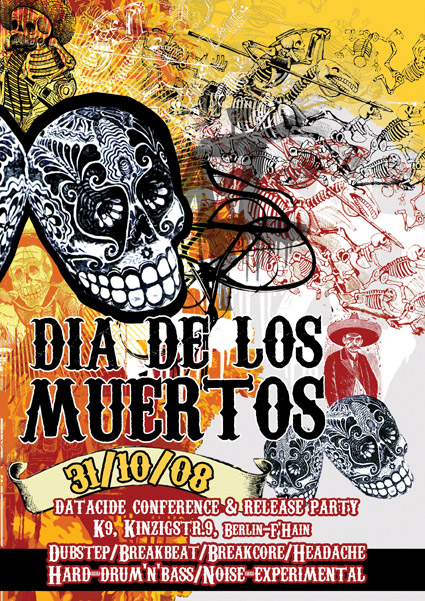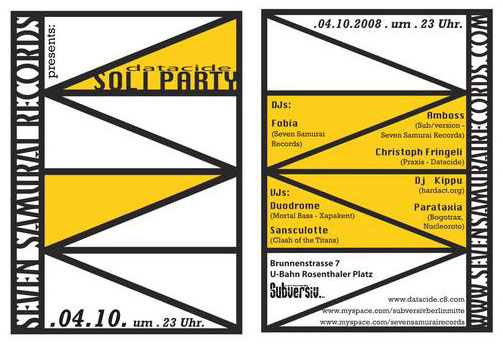Datacide Conference 2008 TIMETABLE
Doors open: 15.00
15.30 – Christoph Fringeli: Introduction to the conference and some thoughts on Hedonism and Revolution
16.15 – Hans-Christian Psaar: Kindertotenlieder for Rave Culture
17.00 – Lauren Graber: Countervailing Forces: Electronic Music Countercultures and Subcultures
17.30 – Alexis Wolton: Tortugan towerblocks: Pirate signals in the 90s
18.00 – John Eden: Shaking The Foundations: Reggae soundsystems meet ‘Big Ben British values’ downtown
19.00 – BREAK
20.00 – Neil Transpontine: A Loop Da Loop Era: towards an (anti)history of ‘rave’
21.00 – Stewart Home: Hallucination Generation
DISCUSSION
Downstairs:
23.00 – Mario D’Andreta (Alien City Soundscapes)
24.00 – Line Destruction (Spine)
24.45 – Circuit Parallele (Spine, Hekate)
1.30 – The Wirebug (Hekate, Coven H, London)
2.30 – DJ Controlled Weirdness (Unearthly, London)
3.30 – Blackmass Plastics (Dirty Needles, U.K.)
4.30 – Kovert (Criticalnoise.net, Datacide, London)
5.30 – El Gusano Rojo (Hijos de Puta)

After the MIKZ has been closed down the event is now taking place at the
K9, Kinzig Str. 9, 10247 Berlin-Friedrichshain
nearest public transport: U5 Samariterstrasse
start from 15.00
Datacide Conference 2008 and Party
DIA DE LOS MUERTOS
31.10.08
K9
Kinzigstr.9
10247 Berlin-Friedrichshain
Doors open 15.00
Conference start at 15.30
Christoph Fringeli: Introduction
A brief introduction to Datacide, where it’s coming from and a brief introduction to the new issue and the conference.
Christoph Fringeli: Hedonism and Revolution
Will true pleasure only exist after the revolution, or will it be indispensable to even lead to the revolution?
Proclaiming the revolutionary as a “doomed man” without “personal interests”, the anarchist Sergey Nechayev set the pace for an ascetic image of the revolutionary that would be picked up by the direct heirs of Bakuninism: the Leninists. An “ideal” of a person without desires and only one passion – the revolution – was supposed to bring about a society of human fullfillment, something that had to go wrong, and end in the misery of the Maoist and Trotzkyist sects. But there has always been a hedonist counter-tendency to this, from Fourier to Sexpol to the Commune movement and the counter cultures of the 60’s to the 90’s. CF will examine some of the tensions and discussions that took place in the 70’s and ask if they have any relevance now.
Neil Transpontine: A Loop Da Loop Era: towards an (anti)history of ‘rave’
(History is Made at Night)
‘In 2008 the UK media have been full of stories about the ’20th annversary of acid house’. Neil Transpontine critiques this conventional history, and celebrates instead the multiple trajectories that converge and pass through the various sonic, social and chemical phenomena grouped under that unstable term ‘rave’. It is a story that takes in not just 303s and 808s but gay riots, carnival uprisings and underground jazz clubs in 1940s Europe’.
Stewart Home: Hallucination Generation
Looking at some of the more occulted aspects of the counterculture in 1960s London. How some of the key figures in the development of the scene rarely make it into the histories. Terry Taylor the first person to mention LSD in a British novel, and the inspiration
for both Absolute Beginners and Mister Love and Justice by a better known writer Colin MacInnes. Detta Whybrow and the first major LSD distribution network in London after the drug was made illegal. Alex Trocchi, drug dealing and black powers. Plus the Notting Hill’s problematic writers of the 1950s who later occupied positions on the outer fringes of the counterculture.
John Eden: Shaking The Foundations: Reggae soundsystems meet ‘Big Ben British values’ downtown
John Eden will examine the contribution reggae soundsystems have contributed to British culture and identity, and what they can teach the global mp3 generation.
John has contributed writing to a vast number of independent publications over the years and currently co-edits Woofah magazine – “a completely DIY rag covering reggae, dubstep and grime”. He has run his own uncarved.org website since 1997.
He began unleashing his musical taste on the world in the mid 80s by wrestling all-comers off the stereo at house parties and standing guard whilst his carefully compiled cassettes played. More recently he has contributed sets to the respected Blogariddims podcast series and played records at a bewildering array of obscure London venues.
Hans-Christian Psaar: Kindertotenlieder for Rave culture.
It´s a common myth in music subcultures to think of themselves as independent. But what happens? Commodities get produced and sold on the market to consumers. No matter if those consumers wear dreadlocks or suits. Rebellion and subversion are labels to sell capitalist goods in the cultural industry. Be creative! Have fun! Those are the new imperatives of post-fordist capitalism and its cultural economies. The talk will show on the examples of The Prodigy and Kid606 how rave music is branded and sold.
Lauren Graber: Countervailing Forces: Electronic Music Countercultures and Subcultures
This paper will open with a discussion of how counterculture and subculture have been defined, and then ask what is at stake when we seek to assess divergent avenues within electronic music in these terms. Central to the operational imperative of subculture is the solidification of style and genre – visible and audible signs connoting sameness and belonging. The tactics of visibility and disappearance enacted as subcultural and countercultural everyday practices will be drawn out through a commentary on the book “Psychedelic White: Goa Trance and the Viscosity of Race” and other oppositional tendencies in experimental electronics.
Alexis Wolton: Tortugan towerblocks: Pirate signals in the 90s
After a clampdown on pirate activity at the end of the 80s, the housing estates of London saw a renewed explosion of pirate stations in the early 90s. During the 90s commentators enthusiastically linked the pirate stations with Hakim Bey’s ideas on pirate utopias, information networks and self-organisation. A decade later the pirates still exist, their relationship to the world radically changed by the internet, but the positivist optimism of 90s technoculture has waned, many of its hopes recuperated by Capital.
A discussion of the history and legacy of pirate radio, the theories of self-organisation that accompanied it and current ideas on participatory media.
OPEN ENDED PANEL DISCUSSION
PARTY:
noise:_____from 23h
Mario D’Andreta (Alien City Soundscapes)
Line Destruction (Spine)
Circuit Parallele (Spine, Hekate)
The Wirebug (Hekate, Coven H, London)
DJ Controlled Weirdness (Unearthly, London)
Blackmass Plastics (Dirty Needles, U.K.)
Kovert (Criticalnoise.net, Datacide, London)
El Gusano Rojo (Hijos de Puta)



